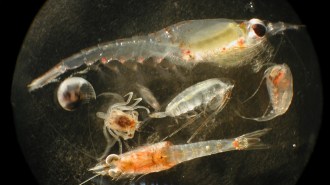- More than 2 years ago
The formation of wispy cirrus clouds is not a simple matter. New research is revealing more about the conditions needed to generate these high-altitude ice clouds and illustrates new ways that pollutants can have consequences many kilometers up in the atmosphere.

Atmospheric scientists have known that when compounds such as sulfates dissolve in water droplets, those tiny airborne solutions can freeze and create cirrus clouds. Also, scientists have known that dust particles can serve as airborne platforms on which vapor freezes. Now, using vapor and particles harvested from the atmosphere, researchers have teased out more details about how cirrus clouds form.
A group led by Paul J. DeMott of Colorado State University in Fort Collins collected air samples at a lab atop a 3-kilometer-high ski mountain at Steamboat Springs, Colo. The team was about as close as it could be without a plane to the 5-kilometer altitude above which cirrus clouds form naturally.
The researchers then streamed their samples through a chamber with adjustable temperature and humidity. When the conditions were right for the formation of ice, the scientists collected crystals, melted them, and identified their chemical and solid components.
DeMott and his colleagues found that dustfree ice formed under conditions predicted by existing models of cirrus clouds, for example, at –42C at a relative humidity of 99.5 percent.
However, the researchers also found that insoluble metal particles and dust in their samples could start the freezing process at a much higher temperature. When this happens, the humidity in the vicinity decreases, preventing the formation of dustfree ice crystals, says DeMott. The scientists report their findings in an upcoming Proceedings of the National Academy of Sciences.
“It’s a competition,” says DeMott. “If there are enough of these insoluble particles, they can control the formation of a cloud.”
This research “shows that cirrus clouds are forming on the same types of particles that people are producing” by such activities as industrial manufacturing, says Brian Toon of the University of Colorado at Boulder. He notes that previous studies showed that cirrus clouds have become more prevalent worldwide over the past 20 years.
The new data could be used to improve models of cirrus cloud formation, the researchers say. Meanwhile, atmospheric scientists are still debating what effect cirrus clouds have on the global climate. Toon and others assert that high-altitude clouds have an Earth-warming effect by trapping incoming solar radiation that otherwise might reflect back out to space. However, increased cirrus-cloud cover could also have a cooling effect by reflecting the sun’s light before it can penetrate to lower altitudes.
****************
If you have a comment on this article that you would like considered for publication in Science News, send it to editors@sciencenews.org. Please include your name and location.







